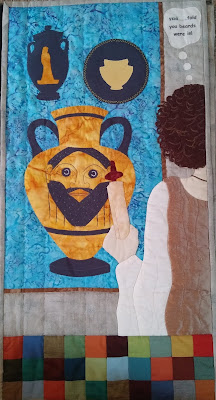Blog 413
I store all our group quilts in a bedroom loft space so they
always come back to me at some stage or other throughout the year. I have just taken charge of our latest group
quilt called ‘Mere Men’ so I have
been able to photo graph each panel and I am sharing them with you this week.
This year we chose a man from all the significant eras of our
island history and stood him in front of a quilt of his time to record his
comments. The size and shape of the man was consistent throughout the panels, as
were the lines of patchwork squares along the bottom. It was actually designed
to hang in a long horizontal row but the dimensions of the entries was altered for
this year’s FOQ and we had to hang it 3 by 3 by 3 instead. Each group member was
given scope to research their era and design a costume and a quilt for that
time. Here they are in chronological order.
Liz’s Greek
“She’s been trading - I should have seen it in the runes”

Jenny’s Elizabethan
“Is it the design for our garden or our second-best bed
cover?”
There is no doubt we have great fun doing these group quilts
although there is always a lot of pressure to do our individual piece well and
on time. This year has been exceptional technique-wise with so much detail for
all to enjoy. We meet next Friday for the first time to discuss any ideas for
next year and who knows where they will take us! Love it love it love it!




















































